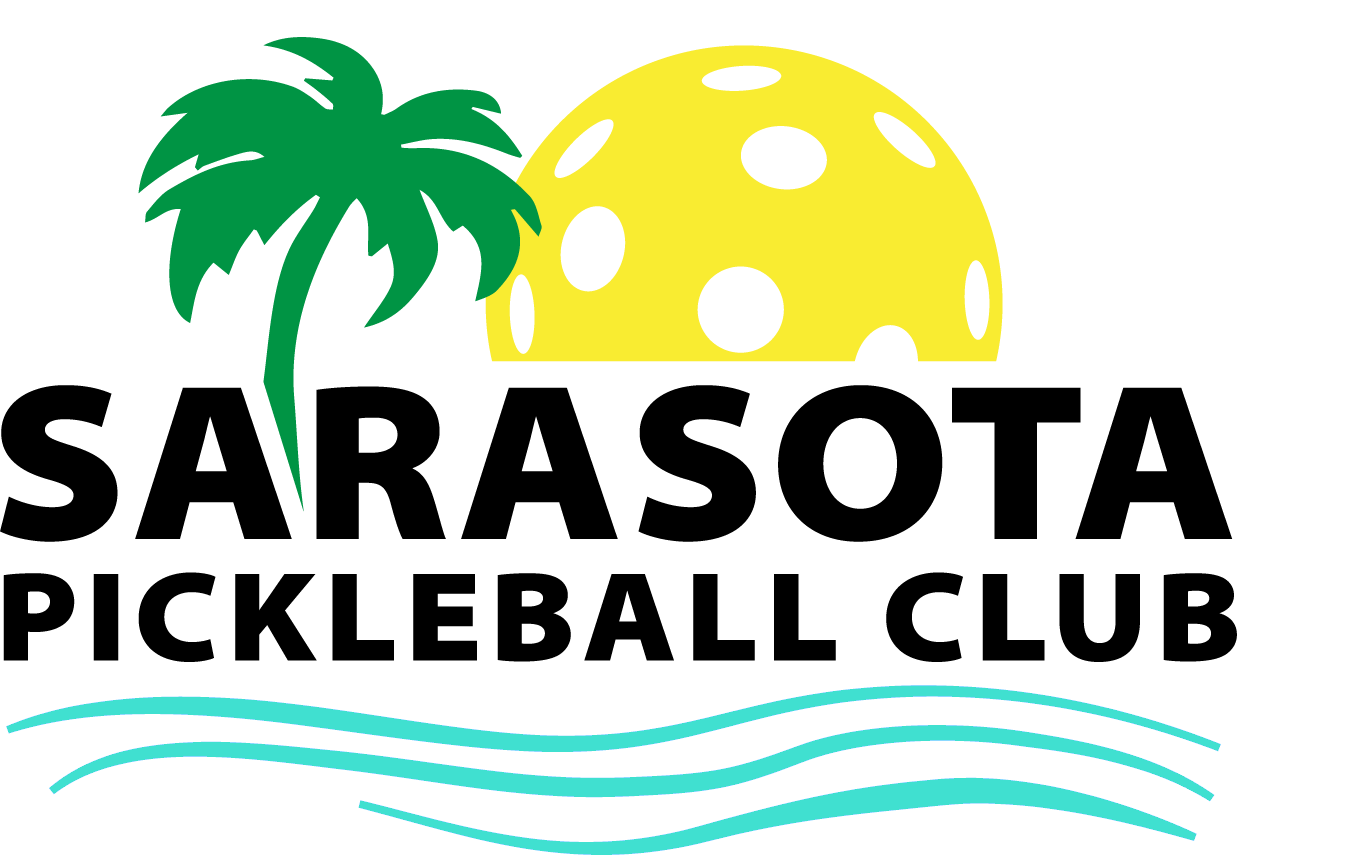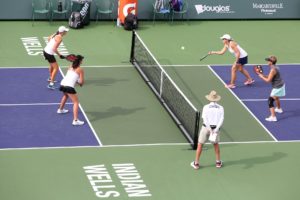The Game of Pickleball
The game of Pickleball was developed so that all members of a family could participate. The rules were kept simple and many of the rules are an adaptation from tennis, ping pong, and badminton.
Here are the basic rules you need to know to get started:
The Two Bounce Rule
The ball must bounce twice, once on each side of the court, before players can hit the ball in the air or on the “volley”. When the ball is served, it bounces in the receivers service court, the serving team must stay back and wait for the ball to bounce again on their side before they can move up and play the ball in the air.
This rule is instrumental in providing long rallies in the game of Pickleball. The serving team cannot serve the ball deep and then run to the net and smash it down “the throat” of their opponents. They must stay back and wait for the return bounce. New players often forget this and start to move up quickly with the serve and get caught hitting the ball in the air.
Both players on the serving team need to be aware to stay back at the service line until the ball has bounced on their side. After the ball has bounced twice either team can play the ball on the bounce or in the air.
The Non-Volley Zone Faults
The Non-Volley Zone, or Kitchen as it is often referred to, is a rectangle that is 7′ X 20 feet on both sides of the net. Since Pickleball was designed as a family game this area was put in place so that a player has to stay back from the net when hitting the ball in the air. Thus, cutting down on the number of smashes and possible injury to an opposing player. This also helps make for longer rallies.
Key Points:
This is one of the most difficult rules
You can go into the NV-zone to get a ball that bounces in there first.
You can stand in the NV-zone all day if you want, you just can not play the ball in the air.
It is a fault if you step in even after the ball is missed or hit by the opponents.
This rule was introduced to prevent players from going to the net and smashing it at their opponents as in tennis. It is safer and longer rallies result because there are fewer “put-aways standing seven feet back from the net.
Points
The game of Pickleball is usually played to a score of 11. The winning team must win by two points or play continues until one team wins by 2. In tournament play, games can be played to 15 or 21. Unlike tennis or badminton, only the serving team can win a point. The receiving team must get the “side down” and get the serve back before earning points.
You earn a point when the other team commits a fault. Faults are described below.
Scoring
Scoring in pickleball can be very confusing to beginners. The first rule of etiquette in pickleball is that the server and only the server should announce the score. The player that is standing in the right-hand service area of the serving side always starts. That player is server number 1 for this sequence only. The next time they get the serve, their partner maybe in the right court to start and they become server number 1.
The sequence for announcing the score is as follows; serving team’s score first, opponents score second and server number third. So if the server announces 3, 4, 1, the serving team has 3 points, the opposing team has 4 points and server number 1 is serving. If the serving team wins a point, the score would be 4, 4, 1. The serving team switches courts after winning a point but the receiving team stays as is.
Remember the server only gets one fault and they lose their serve. You only get one chance to get your serve in, not two as in tennis.
Serving
To start the game, teams may decide to rally for serve playing the ball three times over the net before it is in play. Often, one team just decides to start. The team serving first gets only one serve their first time. This rule helps prevent “blow” out games with one team getting a large number of points to start. The server making the first serve should announce 0, 0, 2. The score is 0, 0, and because the team gets only one serve, the server is number 2. When the serve switches to the other side that team gets two serves and play continues that way until a score of 11 is reached.
The server must serve underhand making contact with the ball below the waist. The top of the paddle face must be below the wrist and the server must have both feet behind the service line at the time of contact with the ball. The ball must be served to the diagonally opposite court and it must be clearly in the service area. The ball cannot hit any part of the non-volley zone including the non-volley line. Before serving the ball, the server should make sure all players are ready. Take a minute to check to make sure your partner is ready and that the opposing team is ready.
The bounce serve in pickleball was introduced under an interim rule during the 2021 season. This rule allows players to bounce the ball before serving, known as the drop serve. The ball must be released from the server’s hand or dropped from the paddle face, from any unaided height, before being hit by the server. There is no restriction on the number of times the ball can bounce before the server hits it. This change was made to provide beginners with an additional and easier way to learn how to serve in pickleball, as the traditional method was challenging to master initially. In 2022, USA Pickleball made this rule permanent, so players can continue to use the drop serve. Remember, the service ball may bounce anywhere on the playing surface, and the serve placement and feet placement rules still apply to the drop serve
If you are receiving the serve but you or your partner are not ready, hold up your hand or paddle. If the server serves to you anyway, do not swing at the ball and call for a “let” serve because you were not ready. Returning the ball indicates you were ready and the point stands.
Calling Lines
Pickleball, like most racquet sports, relies on the integrity of the players in calling shots in or out. The rule of etiquette suggests that players will call the lines as honestly and fairly as they can.
Players should call the lines on their side of the net and opponents will do the same on their side.
Opponents should never make a call on the other side of the net unless they are asked.
If a team cannot decide on a line call, then the benefit always goes to the opponent.
If a team asks for an opinion from an opponent, that decision is final. Again, fairness is the rule of the day.
Remember it is only a game. Keeping this in mind, will prevent conflict on the court.
Faults
A point is earned or a serve is lost if a fault occurs.
A point can only be scored by the serving team.
Fault: occurs on a serve when the ball hits short of the service court including the non-volley line.
Fault: If the ball is served to the wrong court, long behind the back service line or out of bounds.
Fault: After the serve, a fault occurs if a player steps in the non-volley court or on the non-volley line while making a volley shot.
Fault: If the ball is hit into the net or other permanent object such as the pole
Fault: Balls that hit outside the boundary lines of the court are considered out and a fault.
Fault: If the ball hits a player.
Fault: If a ball is hit into the wrong court and the opposing player in that court is hit or catches the ball that is considered a fault on the receiving team.
Fault: A player should not catch a ball that is heading out of bounds Always let the ball bounce first. An indication of an out ball should be made by yelling out or by hand gesture indicating out. This should be done quickly.
Fault: Failing to hit the ball before it bounces twice. However, if the ball bounces twice off your paddle while you are making a continuous forward motion, this is legal.
Fault: If the ball hits any part of your paddle hand, the hand below the wrist, this is considered part of the paddle and is legal.
Fault: If a ball hits a player or his/her clothing, while standing on or off the court during a rally. This is a point for the opponents.

